POPULAR CUISINES PRESENT IN LISBON’S DINING SCENE TODAY

Just like it happens in most big cities, in Lisbon today you could go out to eat and enjoy a myriad of cuisines – sometimes, even under the same roof! We have Portuguese restaurants, restaurants which were founded by folks coming from Portugal’s ex-colonies (namely in Africa and Brazil), restaurants which appeal to a demanding crowd eager to try some of the world’s most famous foods, chain restaurants which you could find pretty much anywhere else in the world, and also restaurants which were started by migrants which cater to their own community while simultaneously gathering new followers.
If only about 5% of the Portuguese population is made out of migrants, today, the largest migrant communities in Lisbon include, in descending order: Brazilians (accounting to about 30% of the total migrant population), British (to be distinguished from other working migrant groups as they’re mostly retired folks), Cape Verdeans, Italians, Indians, Romenians, Ucranians, French and Chinese.
We’re about to see how they’ve all influenced Lisbon’s dining scene, cohabiting in a food scene also shaped by other global food trends!
Brazilian restaurants in Lisbon
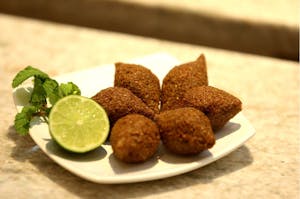
The year was 1500, when the Portuguese accidentally reached the shores of Brazil trying to make their way to India. Even though this land across the Atlantic had little to do with the bounty of spices navigator Pedro Alvarez Cabral and his crew were searching for, they certainly couldn’t ignore that other interesting ingredients (and other valuable goods like red wood to make dye) were to also be discovered around here. The Portuguese weren’t shy to use brutal force to be able to extract the most resources they could from Brazil. This translated into a colonial rule of Brazil between 1500 and 1822.
During this time, and even afterwards (mainly after the 1960s, but more significantly in the early 80s, and late 90s/early 2000s, following the need to look for better working and living opportunities), the cultural exchange between Portugal and Brazil proved intense. Today, Portugal offers fairly relaxed immigration rules to Brazilians, which have such a strong culture that can surely be felt no matter where they go. What’s interesting when we look at the Brazilian food scene in Lisbon is that there are dishes that originated in Portugal, such as feijoada beans and meats stew, made their way to Brazil where they were adapted to local taste and ingredients (with the input of local indigenous populations and African descent folks who were brought to Brazil as a consequence of the transatlantic slave trade), and eventually came back to Portugal via Brazilian migrants. Whether you go to a Brazilian, a Portuguese, or a Brazilian-Portuguese restaurant in Lisbon, you can see menus simply mentioning feijoada (the generic Portuguese version) or feijoada à Transmontana (the regional version from Tras-os-Montes, which in Portugal is regarded as “the original one”), or feijoada Brasileira (with essential elements the Portuguese version won’t feature, such as farofa, a toasted cassava meal).
Portuguese influence traveled to Brazil, where it got mixed not only with native indigenous influences, at a first stance, but later on also took in elements from other Europeans and Middle Easterners who’d started calling Brazil home at different points in history. The Brazilian food we find in Lisbon today was brought over by Brazilian immigrants who came to Portugal, but interestingly enough, in a web of delicious multiculturalism, has components from cuisines of the other emigrants who also went to Brazil over the decades. A good example of this would be kibe, a ground meat fritter which in Lisbon is often found at Brazilian eateries and thus associated with Brazil, but that was originally brought over by Syrian and Lebanese emigrants to South America.

Photo from The Guardian (photograph: PR)
For authentic Brazilian cuisine in Lisbon, we recommend visiting Comida de Santo (Calçada Eng. Miguel Pais 39), which serves food from the Bahia region, including the unmissable Afro-Brazilian shrimp and coconut milk stew known as vatapá; Boteco da Dri (Cais Gás 19 Armazém A, Porta 17B), with a menu of snacks and mains inspired by typical Rio de Janeiro’s eateries; or Boteco Dona Luzia (Avenida 5 de Outubro 36D) for a delicious feijoada with proper side such as farofa, fried plantains and orange slices – available on Saturdays only! If you’re in the mood for a BBQ overload, chain Fogo de Chão (with several restaurants around the city) is a very popular option for meats rodízio, that is, all-you-can-eat Brazilian churrasco.
Different African cuisines you should try in Lisbon
It has to be said: Lisbon is a great place to eat African food! To be more specific, and because we wouldn’t want to make the mistake of grouping all of the continent’s cuisines under the same label (something that is annoyingly done to no end in different contexts), we’re specifically talking about foods from African countries which were former colonies of Portugal: Angola, Cape Verde, Guinea-Bissau, Mozambique, and São Tomé and Príncipe.
Even though Portugal’s first contact with African territories had happened as early as the 1400s, when the Portuguese conquered Ceuta and, some decades later, when they were trying to complete the maritime way to India, Portugal only truly focused on what were to become its African colonies after it had already lost control of Brazil and other Asian territories. The motivation was to be able to compete with other European powers present in the African continent, namely the British and French. The history of Portuguese Africa is long, rich and troubled (we explore it more in depth here!) and has resulted in an immense cultural exchange between Portugal and the African nations we mentioned above. Not only during the years of colonialism but, perhaps even more notably, after these countries gained their independence from Portugal. Several African communities started arriving in Portugal in the mid 1970s, and mainly after the mid 1980s, during a period of bigger economic growth that would supposedly grant better opportunities to those arriving in our country. Now-a-days, Black Portuguese aren’t only migrants, but mostly African-descent second-generation individuals which are now officially Portuguese, but that certainly still have the natural ability of carrying at least some of their traditions (and typical dishes) forward.
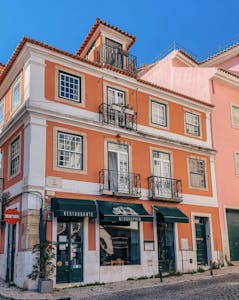
Geographia Restaurant with “food that speaks Portuguese, from the four continents” (© geographia.restaurante at IG).
If today, for example, it is easy to find Cape Verdean food or Mozambican restaurants around Lisbon, we can’t also overlook how these and other African cuisines have had an impact on Portuguese cooking. Just like it happened with the example of Brazil above, some elements originated in Portugal, traveled to a given part of Africa, re-shaped themselves according to local and international influences present over there, and eventually came back to Lisbon. Of course we could always go one step further, and try to pin down the exact origin of a given food or dish, but that’s a task with virtually no end. Care to analyze an example with us for a moment? Xerém (or xarém) is a corn porridge regarded in Portugal as being typical from the southern Algarve region. There, it is known that this is an inherited food from the times of the Moorish occupation in the Iberian Peninsula, around the 8th century. It is important to note that other grains rather than corn would have to be used by the Arabs from northern Africa, as corn only arrived in this part of the world after the Columbian Exchange. Now-a-days, xerém is widely popular in Cape verde (as well as in Brazil) and it is seen as a Portuguese origin food. This corn porridge tends to vary as it is prepared with local ingredients (for example clams and cockles in the Algarve, tuna or pork in Cape verde, or in Brazil with either pork or a mix of this and other meats). Today in Lisbon, you are more likely to come across Cape Verdean xerém than the Portuguese version from the Algarve!
If you don’t have time to dine at several of Lisbon’s greatest African restaurants, we’d suggest visiting Geographia (Rua do Conde 1), an establishment which prepares “food that speaks Portuguese”’, that is, dishes from Portugal’s ex-colonies, part of the Lusophone Commonwealth. This includes the African countries which we were just talking about, but also Brazil, Goa (India), Macau (now-a-days a part of China), and East Timor. Everything is properly labeled on the menu (including the drinks!), so that you can learn more about this exchange of cultures in the Portuguese-speaking world, but most of all so that you can take a quick trip around the globe with your tastebuds!
Criolense Kitchen Club (Rua Damasceno Monteiro 12) won’t pop up when you search for the best African restaurants in Lisbon – this, and the fact that they serve incredible food in such a unique atmosphere, makes it a true hidden gem! They promote themselves as a restaurant for “contemporary black food” and, more than food, it offers an experience, with good music and awesome vibes. With a different feel to Criolense, but a few lively things in common, Casa Mocambo (Rua do Vale de Santo António 122A) is also a pan-African restaurant in Lisbon – it actually markets itself as Afro-Lisboan! – which brings under one roof food from different African nations, as well as music and other cultural expressions.
For country specific African restaurants from former Portuguese colonies here in Lisbon, we also recommend:
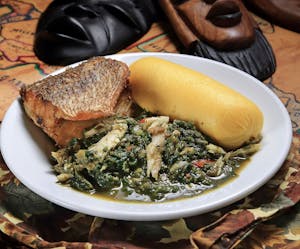
Calulu, traditional dish from Angola
Angola: Casa de Angola (Travessa da Fábrica das Sedas 7) is a gastronomic and cultural space which has been open since 1970, and offers dishes like muamba chicken (considered the national dish of Angola) or mufete (a grilled fish dish from the colonial times), which can make you nostalgic for Angola, even if you have never been there! At Gingolé (Rua Vieira da Silva 14-A, Odivelas) you can also try the aforementioned dishes, as well as calulu, an Angolan stew which can be prepared with dried fish or meat.
Cape Verde: if there is one African cuisine that is indeed very well represented in Lisbon, that is Cape Verdean! We start our recommendations with Tambarina, a popular yet unassuming family-run restaurant which has two locations in Lisbon, and serves incredible value for money cachupa (a stew of corn, beans, cassava, sweet potato, fish or meat, simmered for a long time) and muamba, as well as home-made ponche (a coconut, condensed milk and grogue cocktail). To eat traditional Cape Verdean food while enjoying live music, go to Djairsound (Rua das Janelas Verdes 22). Associação Caboverdeana (Rua Duque de Palmela 2, 8th floor) is a non-profit institution whose goal is to keep Cape Verdean culture alive and well in Lisbon. They manage to do so via several cultural initiatives, including the restaurant at the top of the building, where they serve dishes like cachupa, muamba, grilled fish and curries.
Guinea-Bissau: Bissau-Guinean food isn’t nearly as well represented in Lisbon as Cape Verdean, Mozambican or Angolan. But if you’re keen on trying food from Guinea-Bissau, you can still count on Delícias Guigui to order online delicacies such as mancarra, a shrimp and peanut stew, or futi, Guinea-Bissau’s take on fried rice, a
common breakfast food. Don’t be mistaken if you come across Estrela da Guiné in the Rato area, as this is a cafe named after Guinea but doesn’t offer a menu different from any other regular Portuguese pastelaria.
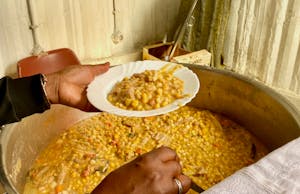
Cap Verdean ‘cachupa’ cooked by a local community in Lisbon outskirts (© Sílvia Olivença)
Mozambique: Cantinho do Aziz (Rua de São Lourenço 5 here in Lisbon, but now also present in Leeds, UK, and New York City, USA) is actually fairly well-known amongst tourists, as it’s been earning accolades from international publications, thanks to dishes such as miamba wa macau (prawns and plantain cooked in a coconut and palm oil sauce) or makoufe (greens in a coconut and peanut sauce). One of the most interesting things about this restaurant is that here you can taste what could be regarded as typical Mozambican food, but also lots of Indian inspired dishes (like goatling xacuti or sweet bebinca) which are now part of the daily foods consumed in Mozambique, thanks to the rich exchange between these countries which was promoted because of the Portuguese explorations (see here!). This is a part of Mozambican, Indian and Portuguese history we get to explore during our Original Lisbon Food and Wine Tour while, of course, we get to sample food that perfectly matches the chronicles! Other Mozambican restaurants in Lisbon worth your visit include Roda Viva (Beco do Mexias 11 R/c) specifically for South-Mozambican food; Chiveve (Rua Andrade Corvo 5D) for skillfully executed food and happy vibes; and Ibo (Compartimento 2, Cais do Sodré Armazém A), for a more up-scale Mozambican dining experience, where you could try delicacies such as prawn curry with okra, or frango à Zambeziana, that is, Mozambique’s take on peri-peri chicken.
Unfortunately, we are unaware of good restaurants focusing on the cuisine of São Tomé and Príncipe in Lisbon these days. There were at least two good ones (Segredos das Ilhas and Kwa Doxi) which didn’t survive the pandemic, proving that Lisbon’s dining scene is (even more so because of the unprecedented times we’re living) very dynamic.
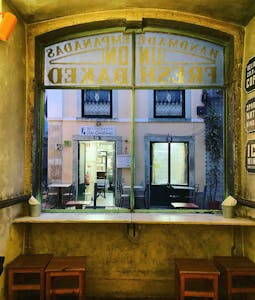
Cape Verdean restaurant in São Cristovão seen from a Mexican street art restaurant (© Sílvia Olivença)
Even though there are dishes which are shared amongst the different cuisines of the restaurants mentioned above (for example muamba and cachupa), we make it a point to recommend based on each nationality. Oftentimes, even here in Portugal where it should be our responsibility to distinguish the differences between countries which not until so long ago were actually a part of our domain, we end up grouping everything together unfairly, not acknowledging the cultural idiosyncrasies of each place. Of course the fact that there are several restaurants which serve foods from different African countries (like, for example, O Nelson – and, of course, there’s nothing wrong with that) doesn’t make it easier for diners to make a proper distinction of the individual cuisines).
Indian food scene in Lisbon (and other Indian sub continental cuisines)
Portuguese and Indian foods have been intrinsically connected for over 500 years. The Portuguese ruled over Goa, in India, for about 450 years, helping redefine Konkan food and eventually giving rise to a whole new cuisine, Goan-Portuguese, famed for dishes like vindaloo, xacuti or bebinca. As India eventually annexed the territory of Goa and the Portuguese had to leave India, Goans were offered the possibility of obtaining Portuguese citizenship. Summing things up, this explains why there are so many Indians and, particularly, Indian-descent individuals in Lisbon today – you can read more about this here!
Goan food is one of the best variants of Indian cuisine you can and should try in Lisbon today! Some of our favorite restaurants include Jesus é Goês (Rua São José 23) for a mix of Indian and Portuguese (temporarily closed); Tentações de Goa (Rua de São Pedro Mártir 23) where you can have a stellar bachao; or Segredos de Goa (Rua Ten. Ferreira Durão 62C) – don’t miss the sarapatel!
But Indian representation in Lisbon isn’t certainly limited to Goans. In fact, when we look at the Indian community in Lisbon we could more broadly speak of the Indian-subcontinent, also including folks from Pakistan, Bangladesh and Nepal. As Portugal offers rather inviting emigration laws (often criticized by the rest of the European Union because of being “too relaxed”), our country proves inviting for emigrants who can live here for short of a decade, claim Portuguese citizenship and, eventually, go live anywhere else in the Schengen area, where they can work for better wages.

On of the restaurant in Benformoso street, where you can have Indian sub-continental community (© Sílvia Olivença)
To get acquainted with the Indian sub-continental community in Lisbon we recommend visiting the area of Martim Moniz and, more specifically, Rua Benformoso, where there are many restaurants, snacks shops, halal butchers, specialized groceries and household items shops. Here, you will mostly find unassuming restaurants with humble looks, yet with authentic flavorful food – after all, the sub-continental community would accept no less! This isn’t the place for bland dishes which might have been adapted to the average Portuguese palate – that is something which for a long time used to be done but that, today, is more likely to happen in a Pan-Asian restaurant.
Some of the best Indian-subcontinental restaurants you should try to sample what migrations to Lisbon taste like include:
Indian: Gunpowder (Rua Nova da Trindade 13) for contemporary Indian cuisine based on Portuguese products; Kerala (Rua Passos Manuel 14) for delicious seafood curries from the Indian Malabar coast; Chutnify (Travessa da Palmeira 44) for a mean Telangana lamb curry and so much more; Cinnamon (Rua de S. Paulo 27) for Indian tapas; and the canteen of the temple of the Hindu Community of Lisbon (Alameda Mahatma Gandhi), for Gujarati homestyle food.
Nepalese: Casa Nepalesa (Av. Elias Garcia 172A), aka the “Temple of Nepalese Cuisine” is consistently highlighted as one of Lisbon’s best Nepalese restaurants, offering elevated Nepalese cuisine in an elegant atmosphere; Himchuli (Rua do Sacramento a Alcântara 48) is also a good option in the neighborhood of Alcântara, where the largest community of Nepalese in Lisbon reside; and so are Sagarmatha Momo (Rua dos Anjos 57A) and Jhol Mo:Mo (Rua Maria Andrade N. 60 C), as the names clearly point out, for momos (Nepalese dumplings).
Bangladeshi: to go beyond the idea of Indian sub continental food a lot of western folks have, and that has mostly been shaped by north-Indian restaurants with menus full of standard items like tandoori grills, butter chicken or naan, we’d highly recommend visiting a Bangladeshi restaurant. Bangladeshi (and, in reality, the food of West Bengal and other north astern provinces of India) has rice and fish and its main staples. Some of the best Bangladeshi (or simply Bangla) restaurants in Lisbon include Dhaka (Rua do Benformoso 220) in what is sometimes known as Lisbon’s “Little Bangladesh”; Ruposhi Bangla (Calçada Agostinho de Carvalho 12) for great value for money Bangladeshi food served alongside Italian specialities; and Bangla (Rua do Benformoso 147), where you can also buy home-made snacks like jalebi (fried sweet with syrup) or singara (samosa) for take-away.
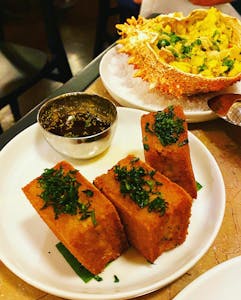
Gunpowder remains one of our favorite surprises since 2022. This night we had among others, CPC prawn toast and the spider crab egg bhurji with salmon caviar (© Sílvia Olivença)
Pakistani: there are little over 3000 Pakistanis in Portugal but, when you roam around certain areas of Martim Moniz and Mouraria you may think there are more. Still Pakistani food in Lisbon is well represented by Taste of Pakistan (Rua de São Pedro Mártir 46), which is great specially for comforting meat dishes; PAK Grelha (Rua Sampaio Bruno 61B) for halal BBQ; and Taste of Punjab (Beco dos Surradores 18) which reminds us that, besides Indian Punjab, there’s also the province of Punjab in Pakistan, and that Pakistani and Indian dishes around here barely know no borders.
Don’t be surprised if you visit a restaurant in Lisbon and it offers more than one Indian sub continental cuisine. Mixing Bangladeshi or Pakistani with Indian, for example, is very common for the sake of a wider market appeal. After all, until the Partition in 1947, these were the same country, so the cuisines (desi foods) do have a lot in common, even if regional differences are so pronounced across the Indian sub continent overall!
The curious world of (legal and illegal) Chinese restaurants in Lisbon
Discriminatorily, Chinese food is often associated with a cheap experience. It happens in the USA, it happens here in Portugal, and it probably happens in several other parts of the world. Furthermore, Chinese emigrants are known to travel to different parts of the world and adapt so much for the sake of making a living, that Chinese food often takes on new flavors and shapes no matter where you go. Authentic Chinese food and versions of Chinese food overseas are way too often incredibly different!
Portugal’s connection to China started centuries ago, when the Portuguese took over Macau in 1557, making it the first European colony in East Asia. Over the centuries, we took a lot of influences from the old continent to Macau, and so there’s no surprise that you can now easily come across dan ta (egg tarts influenced by Portuguese pastel de nata) or salted cod dishes over there. Macanese food is indeed a blend of Cantonese and European, specifically Portuguese. Conversely, here in Lisbon, you could try Macanese cuisine visiting Macau Dim Sum (Rua Dom João V 31B), aka Yum Cha Garden, for dim sum that goes way beyond the obvious choice of dumplings; or the Macanese stall inside Mercado Oriental Martim Moniz (Praça Martim Moniz), a food court entirely dedicated to Asian foods.
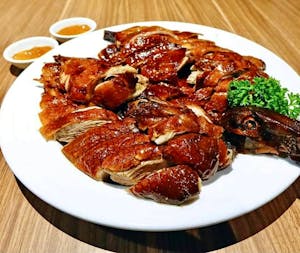
Pekin Duck (© Palácio Hong Kong)
Lisbon’s Chinese community today is strong and keeps on growing (mostly made up of families who came to Europe to do business and seek a better living, and plenty of second generation Chinese who have already been born in Portugal), and so we’re lucky to have access to incredible Chinese food, sometimes, even in an unlikely setting. We’re referring to the so-called “clandestine” Chinese restaurants of Lisbon, which aren’t businesses open in a commercial space but, instead, in private family homes. These aren’t spaces with signage on the facade of the building. You ought to know the exact address, ring the bell, be buzzed in and eventually take a seat in a make-shift dining room in someone’s home, for what has the potential to be some of the most authentic Chinese food you can find in Lisbon. These aren’t places for westernized versions of Chinese food! Most of the addresses of Lisbon’s illegal (or should we say unofficial?) Chinese restaurants are around the neighborhood of Mouraria. Hit us up on Instagram if you’d like to know a couple of addresses!
If you prefer to keep your dining experience within the parameters of legality, and because there are plenty of demanding Chinese customers that make sure these restaurants serve food the way they expect it (don’t be surprised if you see Chinese customers requesting a separate menu!), excellent options also include: Nova Pequim (Av. República 64), former Nova Paris, for Sichuan food; Grande Palácio Hong Kong (Rua Pascoal de Melo 8) for Cantonese specialities; Da Wanmian (Calçada da Mouraria 14), quite probably, the greatest value for money Chinese meal you can have in Lisbon, with huge portions of soups with chewy noodles you’ll see being freshly made on the spot if you peek into the kitchen; and The Old House (Rua Pimenta 9), the fanciest Chinese restaurant in Lisbon, focusing on the flavors of the Sichuan province. We’re pleased to see elevated Chinese dining experiences such as The Old House come up, as this helps fight the way too often eurocentrism we find associated with the world of food, and in particular of fine dining!
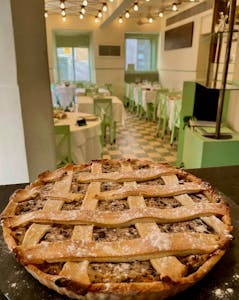
Casanostra restaurant, is one of the first Italian restaurants in Lisbon. For us, is like family!
What European foods can we eat in Lisbon?
At first sight, we could link the fact that there are just so many Italian restaurants in Lisbon to the fact that Italians do make up a considerable number of the migrant population in our city. But, when we look at world trends, the truth is that Italian is such a consensual cuisine, that Italian eateries of all sorts, from pizza joints to regional Italian restaurants, tend to be quite present in most of the world’s major cities. If you wish to indulge in high quality Italian cooking while in Lisbon, we’d suggest: Casanostra (Tv. do Poço da Cidade 60), one of the most acclaimed Italian restaurants in Lisbon; Clube de Vídeo (Rua do Grilo 98), an eatery with home-style food where the menu changes everyday according to what’s available on the market; Café Mortara (Rua Angelina Vidal 23) for fresh handmade pasta; Nonna Goes Crazy (Rua de Santo António da Glória 6B) where Lisbon resident Italians Angelica, Matteo, Luca and Giovanni will make you question everything you thought you new about Italian food; and Osteria Cucina di Amici (Rua Madres 52) which coins itself as a tavern more than a restaurant – and, because that translates into flavorful unpretentious dishes in a relaxed atmosphere, we love that! Italian ice-cream is also very prevalent in Lisbon, thanks to Italian immigrants who settled in Portugal, well aware of our seemingly never ending sweet-tooth. Some of the best gelato in Lisbon includes Nannarella (Rua Nova da Piedade 64A), Nivà (Rua Prior do Crato 40), Unico Gelato (Av. Dom Carlos i 92), Gelato Davvero (Av. Dom Carlos I 39) and, last but not least, Santini (several locations in and around Lisbon), an institution of Italian gelato in Lisbon since Italian born Atillio Santini opened the original Estoril location back in 1948.
The number of French people in Lisbon is fairly considerable and if there is one thing the French are quite particular about, that is food. As such, the city has a few good French restaurants so that French people can feel “at home” while also showcasing the wonders of French cuisine to Lisboetas and other international travelers who visit our city. Our peaks include Bistrô4 (Rua Rosa Araújo 8) where bistro style food and fine dining blend into one (the so-called bistronomie); Comptoir Parisien (Rua Vieira Portuense 44) for typical French cuisine as we’ve come to expect it; and Brasserie de L’Entrecôte (with several locations), a classic of French food in Lisbon since 1993. Because talking about French food without including French pâtisserie would probably be a crime, don’t miss the cakes, viennoiserie and other baked goods of places such as Pâtisserie Dacquoise (Rua Tomás da Anunciação 109A), Ceres Boulangerie (Rua de São Bento 78), La Boulangerie (Rua do Olival 42), and L’éclair (Av. Duque de Ávila 44).
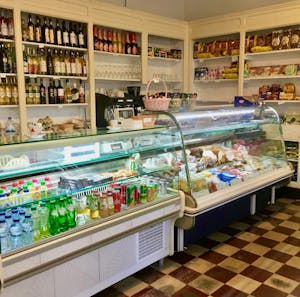
Cantinho Romeno (© cantinho_romeno at IG)
Romanians and Portuguese have quite a lot in common. First of all, Romanians tend to learn Portuguese so well (because both of these languages are Romance) that sometimes you won’t be able to tell that these aren’t folks who weren’t necessarily born and raised in Portugal. Besides language there are cultural similarities (by the way, if you are interested in Romanian culture, Instituto Cultural Romeno in Lisbon tends to have a great program!) which make Romanians decide on Portugal as a country to migrate to, where even though salaries are not as good as elsewhere in Europe, the lifestyle is similar to back in their country, and the overall quality of life is decent. We could also easily draw parallels between Portuguese and Romanian cuisines. Traditionally, both countries favor soups and one pot stews, pork is one of the main meats, and alcohol is consumed with meals. To try genuine Romanian cuisine in Lisbon you could visit Cantinho Romeno (Rua Carlos Mardel 119) which serves Romanian petiscos, that is small portions akin to tapas – don’t miss the mămăligă, a yellow maize flour porridge with various toppings, which is one of the most defining foods of Romanian cuisine! This hybrid of eaterie and specialized grocery store also sells snacks or other typical Romanian foods to eat at home, such as charcuterie, cheeses, cakes and more. Caseiros da Helena (Rua Elias Garcia, Amadora) focuses on Romanian food and home-made baked goods, like tarta cu branza dulce (Romanian cheesecake), kürtőskalács (chimkey cake), or covrigei (Romanian pretzels). You can tell that Helena’s primary customers are her fellow Romanian country people, just by browsing her social media accounts where she posts in their own language. For us, that’s a very good sign, as it makes us feel like we can get something to eat as close as possible as if we were actually in Romania!
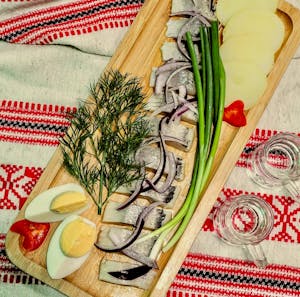
Akcentt restaurant (© akcentt__ukrainian_cuisine at IG)
Even though the Ukrainian population in Lisbon is indeed quite large, most Portuguese folks aren’t all that familiar with Ukrainian eats. Furthermore, Ukrainian food tends to be grouped with Russian cuisine in certain establishments. A Tapadinha (Calçada da Tapada 41) is, by far, Lisbon’s most popular Russian restaurant and, because of the current war, its business has been suffering greatly. Interestingly, the chef at A Tapadinha is Ukrainian, and if we can once again use food as a way to bridge our differences, we would recommend paying this establishment a visit and directly ask the staff for recommended dishes to try. Recently, A Tapadinha has rebranded itself from a Russian to a Slavic restaurant. As the menu remains the same, this makes us reflect on how cuisines can’t indeed be constrained because of political borders. As the foods we eat and love have to do with our background and family history, no man-made borders can ever put a limit on the taste of familiarity or nostalgia. At Akcentt (Rua Barão de Sabrosa 16A) you can try українська кухня, that is, bonafide Ukrainian cuisine, including borscht (beetroot soup), salo (cured pork fat, considered the national dish of Ukraine) and cheburek (a deep-fried turnover stuffed with ground meat). As Akcentt is more a bar than a restaurant, expect these to be finger foods to keep your drink in good Ukrainian company!
Last but not least, let’s mention the British population in Lisbon and how they’ve impacted the local food scene. Or should we say bar scene? Indeed you will find that most British businesses in town are associated with drinks and nightlife, rather than with food. More than actual restaurants, what we do indeed have a decent variety of are stores specializing in products expats (from Britain but also American and other parts of the world – when they brand it as “international supermarket” it generally means that is mostly focuses on products from Anglo-saxon countries) often miss from back home. Things like specific brand name crisps or biscuits can be found at Glood (several locations), Flavers (Rua de São Bernardo 128) or GB Store (Av. Comunidades Europeias 415, Cascais).
Best fusion restaurants in Lisbon
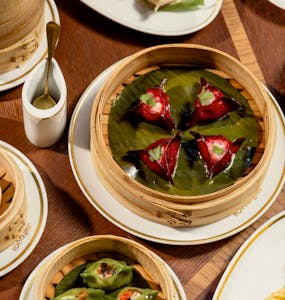
JNcQUOI Asia in Lisbon (© jncquoi.world on IG)
We can’t certainly list all of Lisbon’s fusion restaurants. But after exploring individual nationalities and establishments focusing on specific regions, we would also like to recommend some of Lisbon’s best restaurants for fusion eats. Note that we’re not covering restaurants that may sometimes be regarded as fusion establishments, when in truth they serve a variety of cuisines under one roof, instead of actually blending these cuisines. An illustrative case of this would be JNcQUOI Asia (Av. da Liberdade 144), which markets itself as the “revelation of the Portuguese legacy in the East”.
Fusion cuisines are a natural consequence of migrant groups meeting local food cultures. For the sake of our exploration here today, we’re focusing on businesses which feature a fusion of Portuguese and other international cuisines. Beyond those chefs and establishments blending Portugal’s culinary heritage with influences from the wider world, of course Lisbon’s dining scene also features concepts which have been imported from other parts of the world – but as this is something you could potentially come across anywhere else in the world, we find that it’d be more fruitful to focus our energy on examples that somehow have to do with the local food traditions. One way or another, the growing offer of Lisbon’s food scene is so rich and in constant mutation that, chances are, diners’ can’t get bored – on the contrary, they are ever more demanding and via their choices, apply pressure on chefs and recipe developers to put their creativity to the best of use!
If you visit Bistro 100 Maneiras (Largo da Trindade 9), you’ll have the chance to taste the mix of Portuguese and (former) Yugoslavian cuisines, along with other European elements, as envisioned by Sarajevo-born celebrity chef Ljubomir Stanisic, coined as “Portugal’s Gordon Ramsay” because of being the presenter of the local version of Hell’s Kitchen. Put aside Stanisic’s often crude TV appearances and you’ll get to savor some of the more creative cooking you’ll come across in Lisbon! This translates into creations such as the platter named The Last Supper, featuring cow head, horseradish, cabbage and somun bread (which is the typical bread used to wrap ćevapi kebabs in The Balkans), paired with unobvious choices of wine which reinforce Bistro 100 Maneiras’ irreverent personality.
If you follow Oh! My Cod on social media you’ll see that, every now and then, we go eat out at the much coveted Taberna da Rua das Flores (Rua das Flores 103). Does it get repetitive? Not at all! This is because chef André Magalhães’ ever-changing menu keeps blending ingredients and cooking techniques from different corners of the world, primarily focusing on the cuisines of Portugal and parts of the world where the Portuguese have historical links with, namely in Asia and Africa. We have particularly enjoyed their tuna stuffed pani-puri, their caldo verde okonomiyaki, and because of our love for garum and its umami-packed rich history, the lettuce with garum too. Overall, this is the kind of restaurant which never ceases to surprise us thus keeps us longing to go back for more!

Baby Corn Nigiri for vegans, at Kabuko (© kabuki_lisboa on IG)
Boi-Cavalo (Rua do Vigário 70B) is another notable Lisbon restaurant which we love. This is a ”casual contemporary restaurant, featuring modern Portuguese food, fueled by the city and its diverse communities”. Chef Hugo Brito original dishes are so worldly yet, at the same time, not only Portuguese but with a lot of Lisbon soul! Beautiful examples of this are the hotteok (Korean pancakes) with collard greens (the same leafy greens used for caldo verde – one of the most typical of Portuguese soups!) and turnip fricassee; the Parisian gnocchi with vanilla and muxama (Portuguese dried tuna); and the tarte tatin with quince and goat cheese ice cream – note that the menu changes almost weekly, so there’s always a good reason to go back and see what Boi-Cavalo has in store for you!
Michelin-starred Kabuki Lisbon (Rua Castilho 77B) is a self-proclaimed “meeting point between Japanese and Mediterranean cultures”. Even though the brand Kabuki originated in Spain, Kabuki managed to carve itself a good place in Lisbon’s fusion fine dining scene, breathing in influences from Japan and incorporating them with the essence of Mediterranean and Portuguese cuisines – after all, the Portuguese were the first Europeans to reach Japan and leave an imprint in the local culture. This mark now travels back to the Iberian Peninsula and redefines itself in the shape of dishes such as tuna sukiyaki croquette, scarlet prawn gyozas, or the intriguing mochi pastel de nata.
But of course fusion eating in Lisbon isn’t limited to inventive fine dining or even medium-fancy restaurants with well-known chefs’ signature. A great example of affordable yet delectable fusion kitchen in Lisbon includes Estrela da Bica (Tv. do Cabral 33) by chef Marta Figueiredo. This is a good case of a restaurant which doesn’t obviously fuse two given cuisines but that, instead, has a self-proclaimed “travels inspired kitchen”. Its basis is decidedly Portuguese, but labeling simply as that wouldn’t be fair. Otherwise, how do you explain dishes like tempura of oysters from the local Sado river with wasabi mayonnaise, or roasted pumpkin with babaganoush, nuts farofa and kimchi?
You could also simply visit the humble standing cafe inside Centro Comercial Mouraria (Praça Martim Moniz) and have a proper home-made north-Indian vegetarian samosa with a squeeze of spicy piri-piri sauce (instead of the customary chutney enjoyed in India) and a strong espresso coffee instead of chai, like both Indians and Portuguese seem to often be doing around there these days! Is this fusion? Well, it certainly doesn’t lack cross-culturalism and we can’t help appreciating that it does so in the most unpretentious of ways!
Other cuisines present in Lisbon thanks to globalization
Besides the communities and restaurants we dig into above, there are many other cuisines which are well represented in Lisbon. But, generally, this has more to do with the “global palate” and even demand by tourists and Lisbon’s expat community, more than being directly linked with migrant communities in Lisbon. One example of this are international brunch cafes, very connected with gentrification, which aren’t specifically Portuguese but rather feature international pop foods the younger crowd (Portuguese, expats and travelers) have come to expect.
There are great restaurants in Lisbon for US American food (including but not limited to fast food chains which often localize some of their items – like the McBifana at McDonald’s!), Latin American food, Pan-Asian, and also Middle Eastern. Until very recently, Caucasian and Middle Eastern food in Lisbon was pretty much limited to late-night kebab joints serving dubious cuts of meat inside your dürüm. Thankfully, today we can count on several regional restaurants to showcase the beautiful cuisines of Turkey, Armenia, Georgia, Iran, Lebanon, Syria, and more. Mezze (Rua Ângela Pinto 40D 22/23) is a delightful example of Middle Eastern cuisine restaurant that has everything to do with community. Mezze was developed by the non-profit organization Pão a Pão, which was founded with the goal to “ promote the integration of refugees through training and employability”. Mezze was welcomed so well by Lisbon’s residents that we believe it has helped broaden the concept of Syria and Middle Eastern food many of us could have had before, while certainly contributing to debunking stereotypes.
We couldn’t possibly refer to all good international restaurants in Lisbon here, but there is one more food-related project we’d like to highlight, as it is connected with the migrations which are as a matter of fact helping to redefine our city’s food scene. We’re talking about Cozinha Popular da Mouraria (Rua das Olarias 5) which, more than a kitchen, is a multicultural space where new ideas are always welcome. Cozinha Popular hosts pop-up diners where Lisbon residents coming from different parts of the world get to showcase their food. Some of the latest events have included Thai, Mexican, Italian, French, Japanese and Vietnamese cuisines. It’s like a supper club for the masses, where pretentiousness is left out the door, where preconceived ideas should also remain.
If there is one cuisine which perhaps embodies globalization the most that is vegetarian and vegan. We tend to refer to plant-based cuisine as being a type of cuisine per se, unlike others, not necessarily linked to a given part of the world. So unless a restaurant labels itself as being vegetarian but specifically from a national or regional cuisine (like it happens with Portuguese vegan restaurant in Lisbon A Minha Avó – Rua São Sebastião da Pedreira 150), more often that not, vegetarian menus breath in a lot of influences from the wider world, namely Asian and Mediterranean (European Mediterranean but aso Middle Eastern). Here in Lisbon, you can easily conclude that the plant-based dining scene is heavily influenced by Brazil, because Brazilians generally have a wider range of vegetable foods than we do here in Portugal, and the Brazilian community (including several chefs and influencers) are doing a beautiful job at sharing their recipes with us while promoting the benefits of a greener diet.
What does the future of Lisbon’s dining scene look like?
“Globalization is not a monolithic force but an evolving set of consequences – some good, some bad and some unintended. It is the new reality.”, John B. Larson
As the world becomes more global and Lisbon is not only home to Portuguese but to a diverse multicultural bunch of people, representation becomes a very relevant consideration. Not only is it great for the general public to enjoy a diversity of foods that might help feed their wanderlust, it’s also important that specific communities feel at home where they are, and are able to showcase their culture and foods, while taking pride in their roots. Straightforward cultural assimilation without nuances can actually work against this and, as the number of foreign residents in Lisbon increases and diversifies, we can only hope that the majority embraces the differences and celebrates them too – if possible, around the table, while sharing a good variety of foods with meaning!
As we looked into above, our observation is that globalization will keep on having at least two polar opposite effects (which do complement each other): if on one hand consumers will get used to international cuisines (as well as fusion foods), this is simultaneously a great moment for specific local expressions of our kitchen to shine though. After all, there have never been so many people dining out and, generally speaking, we’re more open than ever before to trying anything new, while also valuing what’s truly traditional and linked to its essence and place of origin.
We believe the key to a successful restaurant in Lisbon will be to focus on more specific dishes and less generic menus (complemented by the service, decor and overall experience), whether they’re Portuguese food or foods from anywhere else. If it’s true that fusion cuisines tend to push cuisines forward, as they’re not limited to traditional recipes, it’s also relevant to safeguard the idiosyncrasies of displaced individuals and their ways of cooking and perceiving food, as a way for them to be able to retain some of their identity.
We also hope that the border between restaurants for Portuguese and visitors vs restaurants for migrating communities for their fellow country people will tend to fade – not because we don’t love a good no-frills restaurant with honest food and affordable prices (we sure do!), but because we think everyone should get to enjoy all sorts of eateries and good food should appeal and be accessible to everyone, no matter their background!
Culinary tradition and cultural diversity and new forms of culinary expression can, and should, co-exist!
